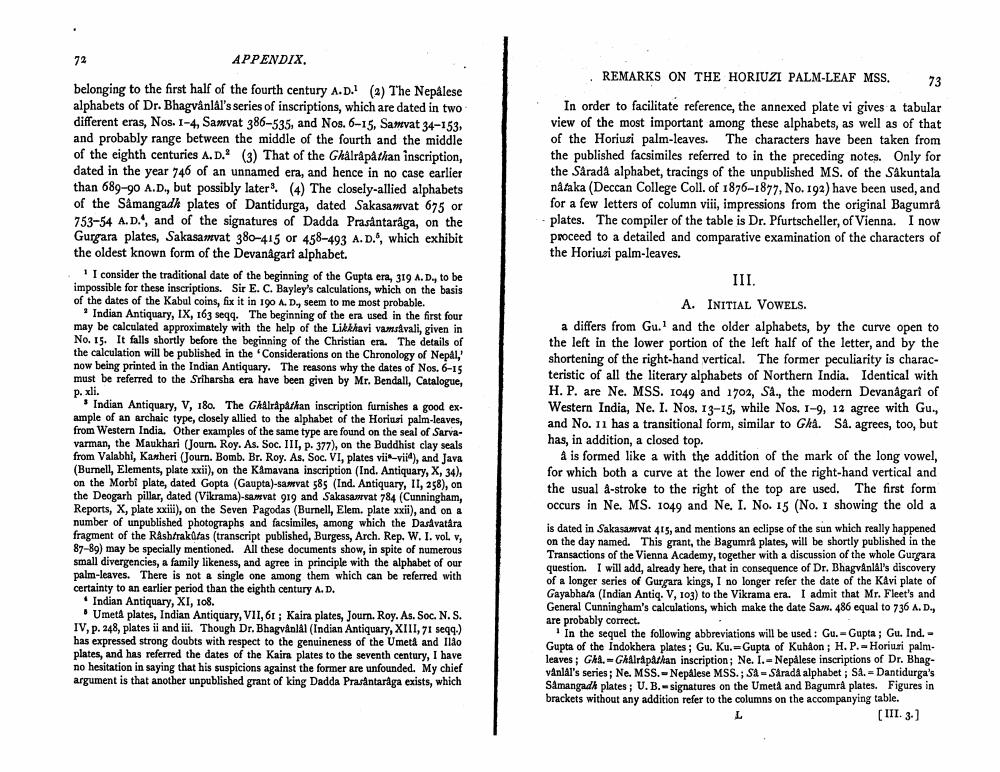________________
APPENDIX,
REMARKS ON THE HORIUZI PALM-LEAF MSS.
73
belonging to the first half of the fourth century A.D. (2) The Nepalese alphabets of Dr. Bhagvanlal's series of inscriptions, which are dated in two different eras, Nos. 1-4, Samvat 386-535, and Nos. 6-15, Samvat 34-153, and probably range between the middle of the fourth and the middle of the eighth centuries A.D. (3) That of the Gkalrapa than inscription, dated in the year 746 of an unnamed era, and hence in no case earlier than 689-90 A.D., but possibly later. (4) The closely-allied alphabets of the Samangadh plates of Dantidurga, dated Sakasawvat 675 or 753-54 A.D., and of the signatures of Dadda Prasåntarága, on the Gurgara plates, Sakasamvat 380-415 or 458-493 A. D.', which exhibit the oldest known form of the Devanagari alphabet.
"I consider the traditional date of the beginning of the Gupta era, 319 A.D., to be impossible for these inscriptions. Sir E.C. Bayley's calculations, which on the basis of the dates of the Kabul coins, fix it in 190 A, D, seem to me most probable.
Indian Antiquary, IX, 163 seqq. The beginning of the era used in the first four may be calculated approximately with the help of the Likklavi vamsavali, given in No. 15. It falls shortly before the beginning of the Christian era. The details of the calculation will be published in the 'Considerations on the Chronology of Nepal, now being printed in the Indian Antiquary. The reasons why the dates of Nos. 6-15 must be referred to the Sriharsha era have been given by Mr. Bendall, Catalogue, P. xli.
Indian Antiquary, V, 180. The Gaalrapatkan inscription furnishes a good example of an archaic type, closely allied to the alphabet of the Horiuri palm-leaves, from Western India. Other examples of the same type are found on the seal of Sarvavarman, the Maukhari (Journ. Roy. As. Soc. III, p. 377), on the Buddhist clay seals from Valabhi, Kanheri (Journ. Bomb. Br. Roy. As. Soc. VI, plates viil-vii, and Java (Burnell, Elements, plate xxii), on the Kamavana inscription (Ind. Antiquary, X, 34), on the Morbi plate, dated Gopta (Gaupta)-samvat 585 (Ind. Antiquary, 1T, 258), on the Deogarh pillar, dated (Vikrama)-samvat 919 and Sakasavat 784 (Cunningham, Reports, X, plate xxiii), on the Seven Pagodas (Burnell, Elem. plate xxii), and on a number of unpublished photographs and facsimiles, among which the Dasavatara fragment of the Rashtraktas (transcript published, Burgess, Arch. Rep. W. I. volv, 87-89) may be specially mentioned. All these documents show, in spite of numerous small divergencies, a family likeness, and agree in principle with the alphabet of our palm-leaves. There is not a single one among them which can be referred with certainty to an earlier period than the eighth century A.D.
Indian Antiquary, XI, 108.
Umeta plates, Indian Antiquary, VII,61; Kaira plates, Journ. Roy. As. Soc. N. S. IV, p. 248, plates ii and iii. Though Dr. Bhagvanlal (Indian Antiquary, XIII, 71 seqq.) has expressed strong doubts with respect to the genuineness of the Umeta and Ildo plates, and has referred the dates of the Kaira plates to the seventh century. I have no hesitation in saying that his suspicions against the former are unfounded. My chief argument is that another unpublished grant of king Dadda Prasantaraga exists, which
In order to facilitate reference, the annexed plate vi gives a tabular view of the most important among these alphabets, as well as of that of the Horiusi palm-leaves. The characters have been taken from the published facsimiles referred to in the preceding notes. Only for the Sarada alphabet, tracings of the unpublished MS. of the Sakuntala nataka (Deccan College Coll. of 1876-1877, No. 192) have been used, and for a few letters of column viii, impressions from the original Bagumra - plates. The compiler of the table is Dr. Pfurtscheller, of Vienna. I now proceed to a detailed and comparative examination of the characters of the Horiusi palm-leaves.
III.
A. INITIAL VOWELS. a differs from Gu. and the older alphabets, by the curve open to the left in the lower portion of the left half of the letter, and by the shortening of the right-hand vertical. The former peculiarity is characteristic of all the literary alphabets of Northern India. Identical with H. P. are Ne. MSS. 1049 and 1702, Sa., the modern Devanagari of Western India, Ne. I. Nos. 13-15, while Nos. 1-9, 12 agree with Gu. and No. 11 has a transitional form, similar to Gha. Sa. agrees, too, but has, in addition, a closed top.
A is formed like a with the addition of the mark of the long vowel, for which both a curve at the lower end of the right-hand vertical and the usual 4-stroke to the right of the top are used. The first form occurs in Ne. MS. 1049 and Ne. I. No. 15 (No. 1 showing the old a is dated in Sakasamvat 415, and mentions an eclipse of the sun which really happened on the day named. This grant, the Bagumrå plates, will be shortly published in the Transactions of the Vienna Academy, together with a discussion of the whole Gurrara question. I will add, already here, that in consequence of Dr. Bhagvanlal's discovery of a longer series of Gurgara kings, I no longer refer the date of the Kavi plate of Gayabha/a (Indian Antiq. V, 103) to the Vikrama era. I admit that Mr. Fleet's and General Cunningham's calculations, which make the date Saw. 486 equal to 736 A.D., are probably correct.
In the sequel the following abbreviations will be used : Gu.= Gupta; Gu. Ind. - Gupta of the Indokhera plates; Gu. Ku.Gupta of Kuhaon; H.P. - Horiusi palmleaves: Gha, Ghalapathan inscription: Ne. I. - Nepalese inscriptions of Dr. Bhagvanlal's series; Ne. MSS.-Nepalese MSS.; S4 - Sarada alphabet ; Sa. Dantidurga's Samangadh plates: U. B. signatures on the Umeta and Bagumrå plates. Figures in brackets without any addition refer to the columns on the accompanying table.
(111. 3.)




